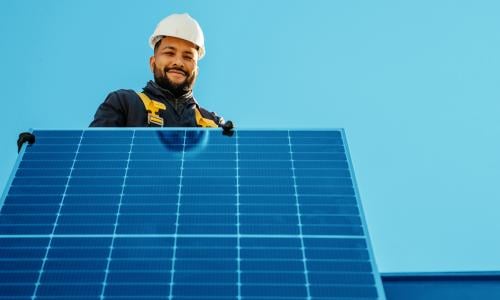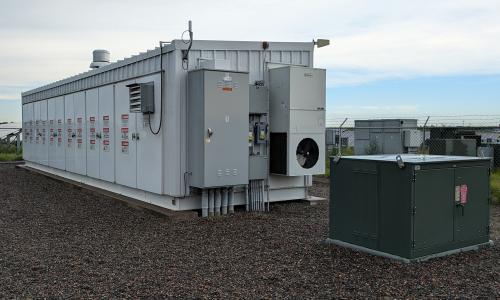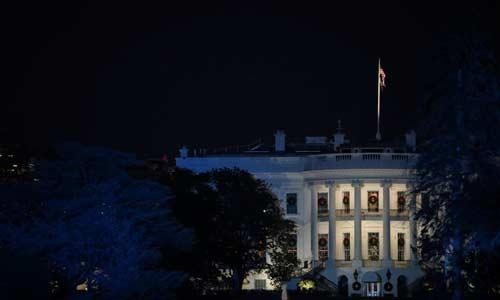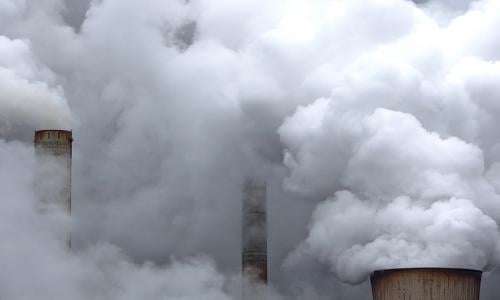Energy analyst John Rogers tells us all about offshore wind, its clean energy benefits and why offshore wind is more feasible than ever before.
In this episode
- John shares exciting developments in wind technology
- John tells Colleen just how much a single turbine can power (it's a lot)
- John and Colleen talk about why offshore wind is great for renewable energy
- Colleen asks how fish and birds handle the presence of turbines
Timing and cues
Opener (0:00-0:57)
Intro (0:57-2:37)
Interview Part 1 (2:37-13:30)
Break (13:30-14:10)
Interview Part 2 (14:10-25:08)
Sidelining Science Throw (25:08-25:20)
Sidelining Science (25:20-29:27)
Outro (29:27-30:16)
Related content
Full transcript
Colleen: So, offshore wind has been a long time in coming here in the US. The first project, the Cape Wind Project off of Cape Cod was proposed in 2001 and my town of Hull, Massachusetts was also trying to put a small group of turbines offshore a few years later. Neither of those came to fruition but it sounds like things are changing. The first commercial offshore wind farm in the US is up and running off Block Island, Rhode Island. And a lot more is coming. So tell me, what's going on with offshore wind and are we gonna see a lot more wind farms along the coast?
John: The first thing to know is that this is an incredibly exciting time in the history of offshore wind in this country. First, it's exciting because we have wind turbines in the water as you said. So, a little under two years ago, a small project went online off of Block Island, Rhode Island. Five turbines, but doing amazing things and one of the things they're doing is helping people understand what these things are and what they aren't. So you can see the turbines, you can, you know, metaphorically kick the tires on these things and there is a lot more coming. And part of that, part of what's driving that is policy.
So two years ago in Massachusetts, we and many others worked to get a law passed that has the state...that the state has utilities, has the local utilities asking for bids for offshore wind. So at that point, it was 1,600 megawatts is what the target was over the next 10 years. Last year, New York, not to be outdone, said, "I see your 1,600, we'll raise it to 2,400 megawatts." New Jersey, the new governor when he came in at the beginning of this year said, and the legislature said, "Let's make it 3,500 megawatts." So we've got this game, not a game, we've got this building up of policies that are saying, this is a technology that we really care about. This is a technology that we want to see off our shores, that we get why this is important.
So I think seeing turbines off of Rhode Island, having Rhode Island take that leadership, seeing Massachusetts, New York, New Jersey, other states really doing it, I mean, that's what's making it real for people. That's what's making it real for the industry so that the offshore wind industry says, "Yeah, this is a place we wanna do business."
Colleen: So it's worth investing in it now because it's happening?
John: It's happening and, you know, this is a technology that what the experience in Europe... Europe, so Europe has been doing this, the first pilot project in Denmark was 27 years ago. The first large-scale, commercial-scale project was 16 years ago. Now we've seen so much, there are close to a dozen countries in Europe, there are five countries in Asia and now the US. So this is actually happening and what the experience shows is that the prices will come down.
Colleen: So Europe and Asia, they've had great success with their offshore wind. There hasn't been any downside or disaster where suddenly the wind stops blowing and there's no electricity.
John: Right. And again, it was really expensive to start with, but countries like Denmark, like the UK, like Germany said, "This is a technology we think is worth investing in." And UK is a really interesting case because they got a later start. So, you know, again, Denmark, 1991, the UK had a pilot project not until 2000. Now the UK has a third of the world's offshore wind capacity. And I actually checked...earlier today, I checked to see how much wind power, offshore wind was doing in the UK, you can see it real-time, it was 14.7% of the country's electricity being supplied by their offshore wind farms.
Colleen: So, that's a lot?
John: Yeah, that's, that's a lot. I mean, if you think about coming from essentially zero just a few years ago to that level, that's, that's quite an accomplishment, and I think gives real hope for the US which is an even later entrant into the offshore wind market.
Colleen: So I know you probably can't answer this, but just hypothetically, is Great Britain...is their goal to get to 50%, 80%? When you're looking at wind for a country, where do they wanna end up?
John: Well, I think what you wanna do is recognize, and countries like the UK are recognizing that we have to get rid of fossil fuels. We have to get off of fossil fuels. We have a range of options for doing that. What they have decided is that [00:05:30] given what resources they have that offshore wind is a great way to go. So they have a strong commitment. They have lots of areas off their shores that are leased to private companies to develop these and they are doing it and they are serious about this.
Colleen: So how much electricity can be generated from a wind turbine, and I know they're different sizes, there will be different answers to this, but if you can give just the very basic explanation, you know, for the layperson and how much electricity can be generated from a wind turbine.
John: Well, so let's look at it in the aggregate first. So I mentioned that the UK has a lot of offshore wind. As of last year, it was powering...it was producing enough electricity to power a fifth of their homes. So something like 5.3 million homes in the UK, that was coming...that's how much electricity was coming from offshore wind. If you look at the largest project under development now, largest project in the world, that single project will provide enough electricity for more than a million homes in the UK.
If you think about in the US, so Massachusetts has just approved the first 800-megawatt project under its 2016 requirement, that project is gonna provide enough electricity for one in six homes in Massachusetts. So just that one project. It's gonna offset the pollution of about 200,000 cars.
Colleen: It seems like more and more states and communities are open to offshore wind at this point. Is that what you're seeing?
John: Definitely. And I think part of it is the price. I mentioned the prices we've seen recently that are so much lower than I think anybody expected, and that makes it a lot easier to say yes to this technology, it makes it a lot harder to say no. That was a barrier, I think, to acceptance. They're also, communities and states are recognizing the economic development opportunities. Those are much easier to picture now that we've actually got wind turbines in the ground in this country. And certainly, the European experience where you see cities, old-time cities like Hull in the UK or Bremerhaven in Germany that have just undergone tremendous revitalizations because, in part, fueled by offshore wind.
Colleen: So I know that a lot of the parts for wind turbines have been...they're built overseas. Do you see that industry coming to the US anytime?
John: So if you think about a wind turbine, or a wind turbine project, an offshore wind project, it's got a lot of things. It's got the blades, it's got the nacelle, the part that sits on top of the tower, it's got the towers, it's got the bases, it's also got the electricians and the pipefitters and the welders and all, it's got the financial aspects. So there're a lot of different pieces and I think what we'll see is pieces of that, you know, more and more pieces of that being set up in this country. So [00:10:45] even with that first project we talked about, Block Island, the bases for that were developed in Louisiana. you know, so we've got a vibrant offshore oil and gas industry, they know how to work in marine environments.
So they've built them there and they floated them up here and shazam, you know, there we have them right there. So I think we'll start to see some of these parts if you think about, you know, the same as we have for land-based wind, some things lend themselves to being made much closer to the project site, other ones you can float them across, you know, across the Atlantic or from Brazil or whatever. So it really depends on the scale of activity and how sort of methodical, how clear a path a manufacturer has to a really big and consistent market.
Colleen: So is energy storage still an issue?
John: It's not really. It's actually much less an issue for offshore wind than for some other technologies. When Massachusetts put out its bid, request for proposals for these, you know, 800 megawatts, that was part of the criteria that said, "What are you gonna do for storage?" And so there were proposals that said, "We're gonna partner with a hydro facility over here," or, "We're gonna build a big battery bank here." The thing about offshore wind is the winds are much steadier offshore which means the turbines are gonna be producing on a more consistent basis. They also produce, they fit pretty well when we're using the electricity, when we need the electricity.
So the times of day or even the times of year to some extent, in New England, that could be winter, they're good winter producers and we're more and more needing power in winter. So it's much less of an issue here for offshore wind than for other technologies.
Colleen: So is there any such thing as community offshore wind? I remember, I think it was a conversation I had with you a while ago about solar panels and solar farms and that if I live in the city, I can buy, you know, a share in a solar farm. Is there anything like that for offshore wind?
John: So if you think about a solar farm, that's a great example and that sort of lends itself to it because solar farms can be any size and they can build it and then, you know, have 100 subscribers like what you're talking about for a community solar system and make that work. When we're talking offshore wind farms, particularly when we're getting not 30 megawatts, but 800 megawatts you're talking, you know, this is billions of dollars that you're talking. So it's a little harder to see buying into that.
There has been an effort including here in Massachusetts for what's called community empowerment, which is letting communities use...so a town or a city use its balance sheet to sort of get behind a project and buy a piece or agree to sort of back a piece of the output from a project. That hasn't passed into law yet in Massachusetts, we're still working on that. But that's a way that you can...not as an individual, but as a community get involved in offshore wind.
[Break]
Colleen: So we are gonna talk in a minute about cool new technologies. But I do have to ask you this question because it does still come up a lot. And the question is, what are the risks to fishing, to lobster traps, to ocean life, and, of course, birds because that's been a big issue in the past?
John: It's a great question and it's certainly worth considering and it is something that gets studied a whole lot before turbines go into the water. If you think about birds, the European experience is that birds, what we've seen at least in some wind farms that are well documented, the birds learn to go around the turbines, around the wind farms themselves completely. Really interesting graphics out there of, looking at flight patterns of birds.
From a marine life perspective, you're altering the seabed. You are putting something on the seabed. For some species, that's probably a problem, for other species, that might be a good thing actually. Because now they have something solid, it's like an artificial reef. In terms of the fishing fleet, you know, they can...people can continue to fish, I mean, you can between the turbines. Obviously, it alters, you don't just have an open field the way you did before, an open sea, but they've certainly learned to accommodate that in Europe and there are solutions.
If you look what, for the Block Island Wind Farm, before that farm happened, there was a whale protocol that was worked out with some leading environmental groups and the developers to say, "Here's what we want to do. You got spotters, they're watching, any sign of a whale anywhere, you stop and you wait until the area's clear, completely clear before you start again." Things like that and, you know, how fast the boats can travel. And sighting. If you sight these things, there are places that are going to be less intrusive, places that are going to be more intrusive from a marine mammal perspective, from a fish, from a fishing perspective.
And actually one of the project's developers in Massachusetts has just reconfigured their turbines to put them farther apart and align them East to West to make them fit fishing habits better. So they are sensitive to that and they are really trying to make sure they're accommodating that.
Colleen: Yeah. So, let's talk current, new turbine technology. I gather there's some pretty innovative stuff happening out there or that's in development. So tell us what's...tell us what you're seeing.
John: So yeah, there are all kinds of exciting things happening and I've got to say, as a mechanical engineer, I find offshore wind turbines just incredibly exciting from a mechanical, from a technological perspective. So what we're seeing in terms of the evolution of the industry is larger wind farms, so the wind farms are getting larger. And so that means costs are coming down in part because of the scale of the projects. They're also coming down because of the size of the turbines. Whereas right now, the standard might be 6 megawatts, we see projects with 8-megawatt wind turbines.
We also see an evolution in terms of the technology for the bases. So they can now do the monopiles, you know, picture just a single pole going down into the seabed, which is the simplest way to do it, maybe. We're seeing that in deeper water. They figured out how to do that. So whereas projects might have been in 20 meters of water, now they can be in 40 meters of water. So 130 feet or whatever.
So that's really neat. We've also just seen the first sort of commercial scale, floating wind turbines off of Scotland. Five turbines, not a big thing, but just showing how you can build these things in port, even in another country, and then tow them into their location. But maybe even neater for the near term is larger turbines. So whereas 6-megawatt might be the standard now, we've seen projects with 8 megawatts. We've now just had the first 8.8-megawatt wind turbines installed. And just to give you give you a sense, these are...I read a quote, there was a quote about offshore wind turbines are now the largest rotating machines on Earth. These are pretty big.
The 8.8 megawatts, what they say is that a single rotation can power a house for a day. These things are big. And they're getting bigger, so that's 8.8 megawatts. There are 10-megawatt or 12-megawatt wind turbines under development. Even bigger than that. So you're really not limited on the sea the way you are on land. You know, there's a limit to what you can truck down the road to the wind farm site. At sea, you can...you just have larger barges and, and taller cranes to build these things.
Colleen: So,
John:, what's the wildest, most innovative technology you've seen?
John: So I think what I'm watching for is these larger turbines...this isn't really wild but the floating wind turbines because those are gonna be important, not for the East Coast of the US, because the Outer Continental Shelf is very shallow for quite a distance and not for if we want to do offshore wind in the Great Lakes, which is a possibility, or off the Gulf Coast, we have possibilities there, but if we want to get to the West Coast, the continental shelf drops off really quickly there and so floating wind turbines are going to be a really interesting piece, really important piece to make that happen.
Colleen: So you're floating them out there to position them.
John: Right. And then...
Colleen: To stay there.
John: And then, so how that floating works, what that configuration is, and then how you attach them to the seabeds. There are lots of questions, lots of things to be worked out there. We as a country, as a world have experience with oil and gas platforms, floating platforms, but the geometry is very different. And so figuring out how this works, figuring out how we make sure that the cables going down to the seabed aren't interfering unduly with marine mammals, with fish, whatever. Those are things that need to be worked out.
Colleen: So it sounds like I'm hearing a lot of positives, but what are the current barriers to bringing on more offshore wind?
John: Well, it's a great question, and until recently, I would have said cost was a big barrier but with the proposal that we just...that Massachusetts is pursuing now or signing for the Massachusetts utilities are getting, cost seems like that's no longer...you know, it'll continue to be an issue, we'll wanna keep dropping the cost, but that really was amazing. So I'd say it's really the newness of this. It's the newness of this for policymakers, for the public at large, for industry that it has to satisfy, has to supply what we're asking for.
So I think there's a lot to be learned and we will learn a lot, whether it's about the, you know, doing this economically or doing this with the lowest environmental impact possible, we'll learn by doing and that's that's what we're doing. That's what we're going to do and I think that adaptive management approach to all of this stuff is gonna be really important.
John: And what we're seeing with this first project that's under development off of Massachusetts is trying to work it out with the fishing industry, make sure that they're comfortable, they can get to a place where they can understand how they can coexist with projects like these. Again, we're doing projects, offshore wind, in part, because of what's happened to our marine ecosystems, to fishing, fish stocks here and around the world. So we want it for addressing climate change. We also want to make sure that it's as compatible as possible with our very rich fishing tradition in New England and beyond.
Colleen: So what do you see as the winning scenario for the US in terms of offshore wind technology?
John: I think everything we've talked about. I think getting to scale is going to be really important. I think having that clear path so that industry understands the level of commitment that we have, we the people have toward this so that they are willing to...that states are saying, "We want it," that, "We want lots of it," that, "We want it now," so that industry can say, "Okay, so it's worth investing in this. It's worth setting up shop here. It's worth putting up a manufacturing plant for this component here, that component there." I think that's what it’s going to take.
The East Coast, I imagine, is gonna continue to lead on this for a bit, but again, there's activity in the Great Lakes. It could be off the Gulf Coast and then as floating wind turbines become more of an option, seeing the West Coast come into the picture, too.
Colleen: So what does your crystal ball tell you for the next year, two years, five years down the road?
John: I think we're gonna continue to see states competing against each other for a piece of this pie. I think we're gonna see a growing recognition that this is something that you don't wanna be left out of. That there is a lot going on here. There's a lot of there, there. So you're gonna see more policies from states and maybe even in the current states. Massachusetts actually just passed another law building on the 2016 law that allows the administration to maybe even up our offshore wind target.
It's gonna take a little bit for the next ones to get in the water but construction could be starting within a year or two, we could...we'll be seeing more of this happening.
Colleen: is there anything the average person can do to encourage offshore wind?
John: Talk it up. I mean, help people understand that if what they've got in their minds when they think of offshore wind is a really expensive project from 15 years ago, they need to update their thinking. Or if they're talking to friends who are stuck in that mindset, just say, "Yeah, actually, look at the latest costs. Look at what's happening in Europe. Look at what's happening in Massachusetts, in Rhode Island, in New York, New Jersey, and all the way down the coast and up to Maine and elsewhere."
Just help people understand the momentum that we're building, the momentum that we have, that this is a technology that is real, it's coming, it's here, and it's gonna be an important part of our electricity mix any day now.
Colleen: And we just, we need more, more, more.
John: We need more, more, more while we're doing, not to the exclusion of all those other things we need to do to address climate change, but so that we have another tool in our toolbox for getting off of coal, for getting off of natural gas, for going beyond fossil fuels. Offshore wind is the real deal.
Colleen: Well, thanks,
John:. It sounds like offshore wind is taking off and we're just really on the right trajectory.
John: It's a technology, an industry definitely worth watching. So thanks for having me, Colleen.
Credits
Sidelining Science: Shreya Durvasula
Editing: Omari Spears
Music: Brian Middleton
Research and writing: Pamela Worth
Executive producer: Rich Hayes
Host: Colleen MacDonald



